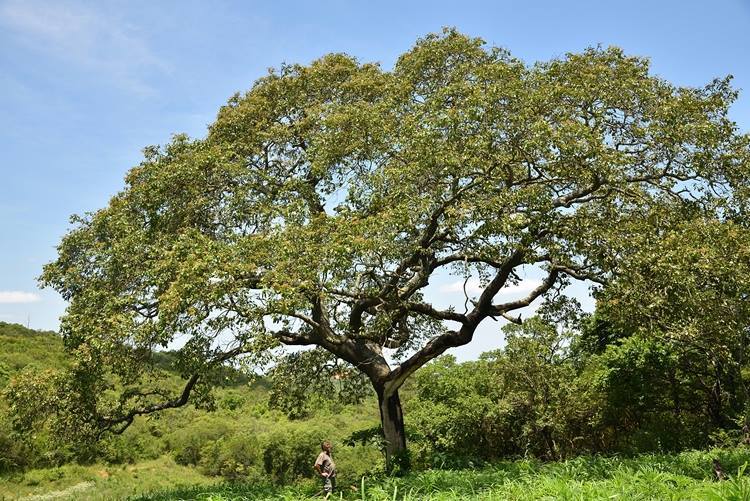Parinari curatellaefolia

|
|
Parinari curatellifolia Common Names: Rough-Skinned Plum, Mobola Plum, Hissing
Tree, Sand Apple Scientific Classification Kingdom: Plantae Clade: Tracheophytes Clade: Angiosperms Clade: Eudicots Order: Malpighiales Family: Chrysobalanaceae Genus: Parinari Species: P. curatellifolia Authority: Planch. ex Benth. Synonyms: Parinari mobola Oliv., Parinari curatellifolia var. mobola (Oliv.) R.E.Fr., Ferolia curatellifolia (Planch. ex Benth.) Kuntze Morphological Description Parinari curatellifolia is an evergreen tree in the Chrysobalanaceae family, varying
from a 3 m shrub to a 20–22 m tree with a dense, mushroom-shaped canopy: · Stem: Single, twisted bole, 25–40 cm in diameter, with dark grey,
rough, fissured bark (Fern, 2024). · Leaves: Alternate, elliptic to oblong, 3–8 cm long, 2–4 cm wide, leathery,
dark green above, greyish-white and hairy below (Barwick, 2004). · Flowers: Small, 5–7 mm, white to pink, fragrant, in dense hairy
panicles, blooming October–January (Burkill, 2000). · Fruit: Oval drupe, 3–5 cm long, yellow-brown when ripe, with sweet,
edible pulp and oil-rich seeds (Fern, 2024). Distribution and Habitat Parinari curatellifolia is widespread across tropical and subtropical Africa: · Range: Senegal to Chad, Kenya to South Africa (Mpumalanga),
including Zimbabwe and Uganda (Fern, 2024). · Habitat: Savannas, woodlands, forest margins, 900–2,200 m altitude;
thrives in sandy, well-drained or poorly drained soils, 14–30°C, 400–1,000 mm
rainfall (Burkill, 2000). Ethnopharmacology Parinari curatellifolia (commonly known as the mobola plum) is a medicinal plant
with various therapeutic properties due to its rich composition of flavonoids,
alkaloids, tannins, saponins, and sterols. It has been traditionally used in
African medicine for its antimicrobial, antioxidant, anti-inflammatory, antidiabetic,
analgesic, and wound-healing properties. Studies have shown that extracts from
its leaves, bark, and fruits exhibit strong antibacterial and antifungal
activity, particularly against Mycobacterium
smegmatis and Candida krusei. The
plant is also known for its antioxidant effects, which help combat oxidative
stress and promote overall health. Additionally, it has been used in
traditional medicine for treating fevers, diarrhea, respiratory infections, and
skin diseases. Some research suggests potential antidiabetic activity, as
compounds in the plant may help regulate blood sugar levels. The oil extracted
from its seeds is used for wound healing and as a skin moisturizer. While
Parinari curatellifolia holds significant medicinal value, further scientific
studies are needed to fully explore its pharmacological potential and develop
standardized medicinal applications. · Eye/Ear Ailments: Root infusions in Uganda treat cataracts
and earaches. Tabuti et al. (2003) document soaking roots for 6 hours as eye
drops. · Pneumonia/Respiratory Issues: Bark decoctions in Zimbabwe for pneumonia. · Anti-inflammatory: Leaf extracts in rats (200 mg/kg) reduced
edema by 24.44% (Mukanganyama et al., 2016). · Antimicrobial: Mawire et al., (2021) study highlight the potential of
Parinari curatellifolia as a source of bioactive compounds with antimicrobial
properties, particularly against Mycobacterium smegmatis and Candida krusei. · Hepatoprotective: Seed flavonoids (20 mg/kg) reduced
acetaminophen-induced liver damage in rats by 70% (Olaleye et al., 2014). ⚠ Toxicity Profile: High doses of seed extract (>500 mg/kg)
caused kidney damage in rats; leaf extracts showed mild hemolysis in vitro
(Mukanganyama et al., 2016). Additional Uses · Food/Nutrition: Fruit pulp eaten raw or in porridge; seeds
(53.9% lipids) roasted or ground into flour (Muchuweti et al., 2013). · Tanning/Dyeing: Bark yields pink-brown dye for baskets and
leather (Burkill, 2000). · Ecological: Fruit supports wildlife; nectar aids honey production;
fire-resistant wood used for charcoal and poles (Fern, 2024). References
External Links More Pictures
|
|
| Compounds of Parinari curatellaefolia | |
| References |